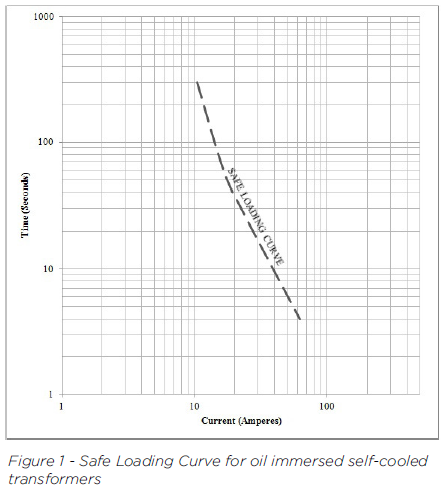Expulsion fuse links are designed for circuit protection from over-current occurrences and developed to closely follow the time-current characteristics (TCC) of most over-current relays used in oil circuit breakers. Proper coordination schemes should maintain both transformer and circuit protection while limiting unnecessary outages.
The curve in Figure 1 drawn on a log-log scale corresponds to the scale used for fuse link TCC curves. This curve represents the allowable short-time overload that an oil-immersed self-cooled transformer can withstand without damage to the insulation, and is used as a guide for application of transformer overload protection. This safe loading curve is based on IEEE C57.109-1993 Guide for Liquid Immersed Transformers Through-Fault-Current Duration.

Hubbell Power Systems, Inc. (HPS) offers a range of six types of CHANCE® fuse links used for system protection and coordination whose relative speeds can be found in Figure 2. Notice the unique “knee” curve shape of the SloFast fuse link. This is caused by the dual element link design that uses a heating coil and solder joint plus a standard copper or copper alloy element in series. These two fusible elements combined provide the unique TCC as shown. Figure 3 illustrates the construction of the SloFast fuse link where the slow and fast sections are clearly indicated.

Figure 2 - Minimum Melting Time-Current Characteristic Curves of Chance Fuse Links

Figure 3 - Illustration of SloFast Fuse Link
As seen in Figure 4, SloFast fuse links are designed so that their TCC follows the safe loading curve of transformers to maintain transformer protection while minimizing unnecessary outages. Secondary temporary faults that can be withstood by a transformer will not rupture a SloFast fuse link. If secondary faults persist and approach a level that could cause transformer damage then slow section of the SloFast link will operate. When a heavy fault occurs within the transformer primary bushings, the fast section of a SloFast link clears the transformer from the system before damage can occur, and before any other protective device can operate and cause an unnecessary interruption to any other segment of the system.

Figure 4 – Safe Loading Comparison of Time-Current Curves of SloFast fuse link with K fuse links
If the SloFast link is used in place of ordinary links, the full overload capacity of the transformer is made available, but at the same time the transformer is protected from faults and overloads which could either destroy or shorten its life expectancy. SloFast is the perfect match for transformer protection.
Note: For application of SloFast links for transformers, see Bulletin 10-8010.









